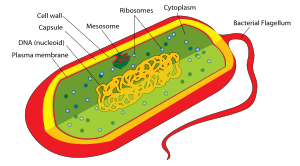Prokaryote facts for kids
Prokaryotes are some of the simplest living things on Earth. They are unicellular organisms, meaning each prokaryote is made of just one cell. The main types of prokaryotes are bacteria and archaea.
Unlike more complex cells (called eukaryotes), prokaryotes usually do not have a cell nucleus. This means their genetic material, which is like the cell's instruction manual, is not stored inside a special compartment. Instead, it's often in a single loop of DNA called a Nucleoid. Prokaryotes also lack many other tiny parts inside their cells called organelles, like vacuoles or the Golgi apparatus. However, they do have ribosomes, which help them make proteins.
Some prokaryotes, like Cyanobacteria (also known as blue-green algae), can make their own food using sunlight, just like plants. Some prokaryotes can also join together to form groups called biofilms. These biofilms can act a bit like simple multicellular organisms.
Prokaryotes reproduce in a simple way, without needing two cells to combine. They just make copies of themselves.
Types of Prokaryotes
In 1977, a scientist named Carl Woese suggested that prokaryotes should be split into two main groups: Bacteria and Archaea. He noticed big differences in how these two groups are built and in their genetic information. This idea led to the "three-domain system" of life, which includes Eukaryota (cells with a nucleus), Bacteria, and Archaea.
Archaea: Life in Extreme Places
Archaea are a fascinating group of prokaryotes. Many of them are known as "extremophiles" because they can live in very harsh environments where most other living things cannot survive.
For example, some Archaea can live in places that are:
- Extremely hot, like geysers or deep-sea "black smokers" (vents that release hot water).
- Extremely cold.
- Very salty, like the Dead Sea.
- Very acidic or very alkaline (the opposite of acidic).
Scientists have even found Archaea living deep inside oil wells!
Images for kids
See also
 In Spanish: Prokaryota para niños
In Spanish: Prokaryota para niños




